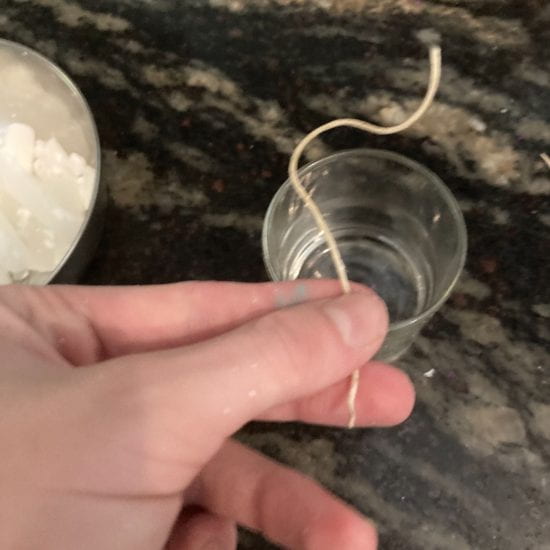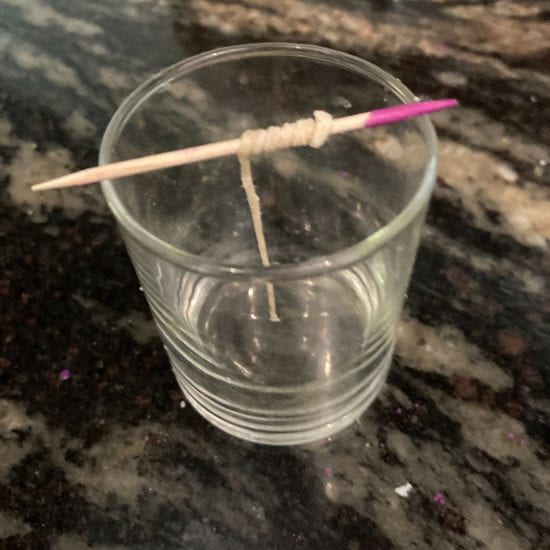This miniature blog post is the second in my CAS series called Mini Blogs. In this little series, I will write some small blogs about CAS-related activities that I have completed, focusing mainly on only one learning outcome. The other learning outcomes related to each blog post will be briefly talked about at the end, with a short sentence about how that learning outcome was addressed with each activity.
A while ago for my birthday, I had received a very pretty and nice-smelling homemade candle from one of my friends. Receiving this candle had reminded me of a time when my brothers and I were younger, and we made some fun, layered and colourful candles out of candle wax and crayons. These two things both inspired me to try to make my own candles.
Main Learning Outcome #2: Demonstrate that challenges have been undertaken, developing new skills in the process A new challenge may be an unfamiliar experience or an extension of an existing one. The newly acquired or developed skills may be shown through experiences that the student has not previously undertaken or through increased expertise in an established area.
 I had only ever tried to make a candle 1 time before, and I was not quite sure how I did that. So, I went out shopping with my dad, and we bought some long candles (so I could use both the wicks and the wax, as well as some colourful wax crayons. Because I had no idea regarding how to go about making these candles, I watched multiple tutorials on youtube, hoping they would give me some direction. However, they all required wax chips or particles, and essential oils. I did not have either of those, so I decided to try out making candles by myself and trying to figure it out through trial and error.
I had only ever tried to make a candle 1 time before, and I was not quite sure how I did that. So, I went out shopping with my dad, and we bought some long candles (so I could use both the wicks and the wax, as well as some colourful wax crayons. Because I had no idea regarding how to go about making these candles, I watched multiple tutorials on youtube, hoping they would give me some direction. However, they all required wax chips or particles, and essential oils. I did not have either of those, so I decided to try out making candles by myself and trying to figure it out through trial and error.
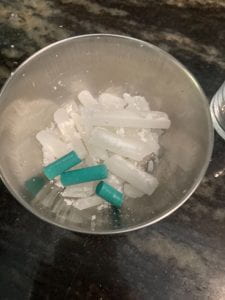
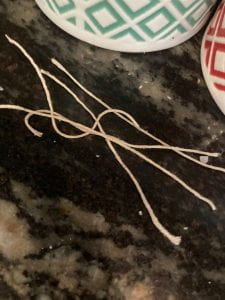 Then, I separated the wax wicks with the wax itself, and I broke up a piece of crayon to put inside the wax. This was for the coloration of the candle. I decided to use green wax at first, to try it out as a colour.
Then, I separated the wax wicks with the wax itself, and I broke up a piece of crayon to put inside the wax. This was for the coloration of the candle. I decided to use green wax at first, to try it out as a colour.
 Then, I used the “double boiler” method to melt my candles. I filled a large saucepan with water, and I placed the smaller metal bowl inside the large saucepan. This helped me melt my wax and crayon into liquid.
Then, I used the “double boiler” method to melt my candles. I filled a large saucepan with water, and I placed the smaller metal bowl inside the large saucepan. This helped me melt my wax and crayon into liquid.
Next, I got my wick and my glass, but I needed to find a way to make the wick stand up straight while the wax dried and was poured in. This was a huge challenge in this process, and after lots of fiddling, I found that wrapping the wick around a toothpick, placed on top of the candle worked really well. This worked well enough. However, the toothpick made it challenging to pour the wax into the candle without spilling it on the side. I wanted to try to make a double-layered candle, so I did not desire the drips on the sides (as I wanted a clear line in the middle.
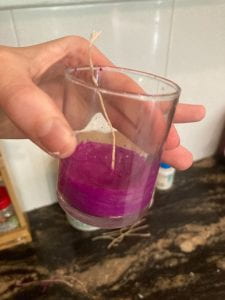
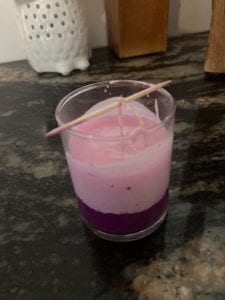 After, while the candle was drying, I did the same process again with a lighter green (which I made by adding a white crayon as well), and I got my achieved look.
After, while the candle was drying, I did the same process again with a lighter green (which I made by adding a white crayon as well), and I got my achieved look.
Then, I repeated the same process with a pink and a darker blue candle.
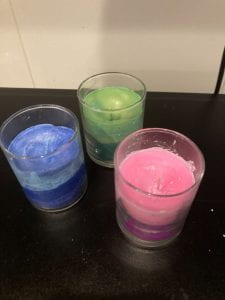 Here are the results of my final candles! I was very happy at the end with how they turned out, and I liked the three colours together. I even added some essential oils that smelled nice while melting to try to get them to be scented.
Here are the results of my final candles! I was very happy at the end with how they turned out, and I liked the three colours together. I even added some essential oils that smelled nice while melting to try to get them to be scented.
This process was definitely an extension of my childhood experience of making candles. This was challenging in many different ways, and those were the little obstacles in the process. However, I did develop my candle-making skills. I am by no means an expert, and as you can see in my final product, there are so many ways I could improve, but I think it is a good start, and I have increased my expertise in this skill area.
Other Learning Outcomes (Shortened):
LO3 Demonstrate how to initiate and plan a CAS experience Students can articulate the stages from conceiving an idea to executing a plan for a CAS experience or series of CAS experiences. This may be accomplished in collaboration with other participants. Students may show their knowledge and awareness by building on a previous experience, or by launching a new idea or process. – I thought up this idea, initiated the shopping and the material gathering, and I also executed this whole project by myself, on my own terms. I came up with this new idea based on my previous childhood experience, and this was how I showed my awareness.
LO4 Show commitment to and perseverance in CAS experiences Students demonstrate regular involvement and active engagement in CAS. – By doing this, I demonstrated a regular commitment to the “creativity” aspect of CAS, as it was a continuation of regular and active engagement of doing creative activities.
